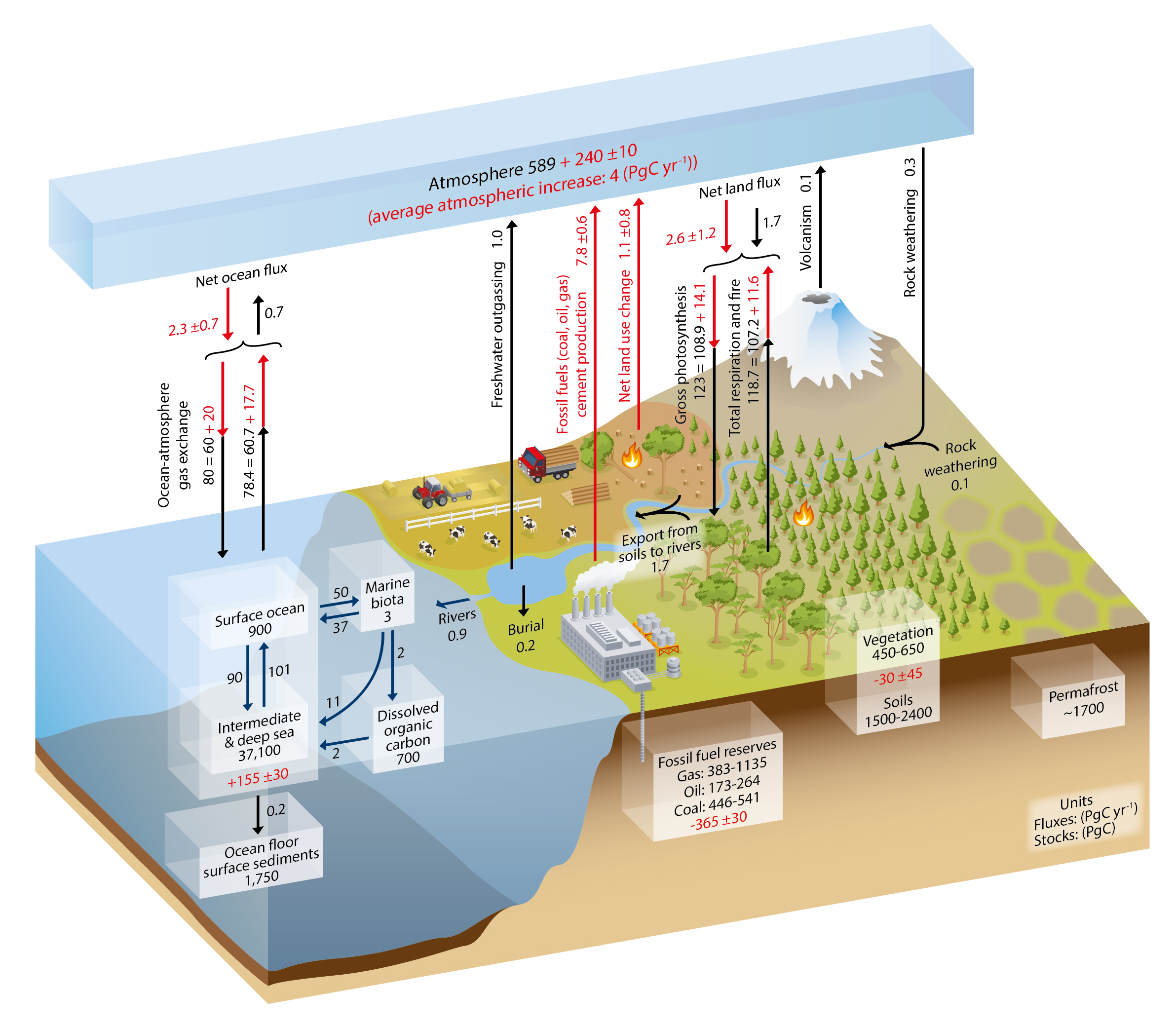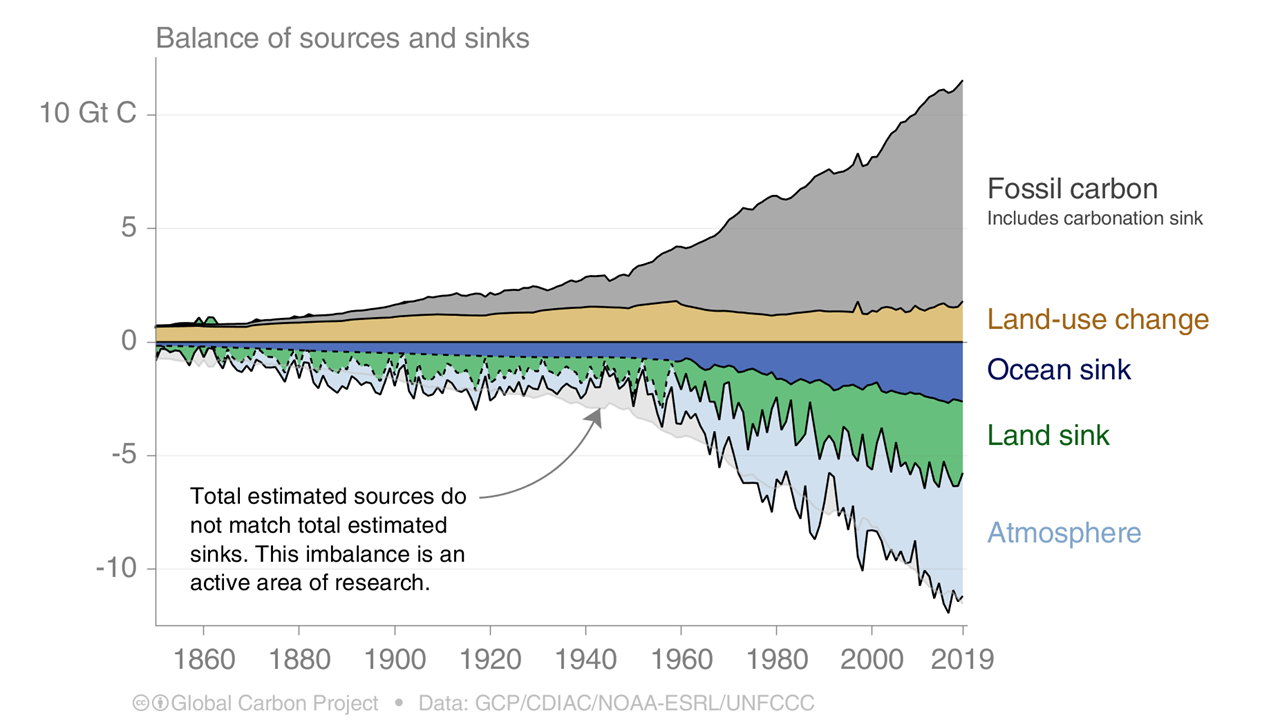Vidéo
Le cycle du carbone est un processus fondamental qui régule la distribution du carbone entre l’atmosphère, les océans, la biosphère terrestre et la lithosphère. Comprendre ce cycle est essentiel pour appréhender les changements climatiques actuels et futurs.
Le cycle naturel du carbone implique des échanges constants entre différents réservoirs. L’atmosphère contient environ 800 gigatonnes de carbone, principalement sous forme de CO2. Les océans constituent le plus grand réservoir actif, avec environ 38 000 gigatonnes de carbone dissous. La biosphère terrestre, comprenant la végétation et les sols, stocke environ 2 000 gigatonnes. Les roches sédimentaires et les combustibles fossiles représentent un énorme réservoir de carbone, estimé à plus de 100 millions de gigatonnes.
Dans le cycle naturel, la photosynthèse des plantes terrestres et du phytoplancton marin absorbe le CO2 atmosphérique, le transformant en matière organique. La respiration des organismes et la décomposition de la matière organique libèrent ce CO2. Les océans jouent un rôle crucial en absorbant et en libérant du CO2 atmosphérique, un processus régulé par la température de surface et l’activité biologique. Sur des échelles de temps géologiques, la formation et l’altération des roches carbonatées influencent également la concentration atmosphérique de CO2.
Figure 1.5.1 : Le Cycle du Carbone. Les chiffres dans les cases représentent la masse des réservoirs, également appelée stocks de carbone, inventaires ou stockage en PgC (1 Pg = 10^15 g = 1 Gt). 2,1 PgC = 1 ppm de CO2 atmosphérique. Les chiffres à côté des flèches indiquent les flux en PgC/an. Les chiffres noirs et les flèches représentent les estimations du cycle du carbone naturel (pré-industriel). Les chiffres et les flèches rouges indiquent les estimations des effets anthropiques pour 2000-2009. De Ciais et al. (2013). Image de ipcc.ch. Voir le matériel supplémentaire à la fin de ce chapitre pour une figure montrant les tailles des réservoirs et des flux proportionnellement à la taille des cases et des flèches.

Le carbone anthropique, résultant des activités humaines, perturbe significativement ce cycle naturel. La combustion des combustibles fossiles et les changements d’utilisation des terres, notamment la déforestation, ont considérablement augmenté la concentration atmosphérique de CO2. Depuis le début de l’ère industrielle, cette concentration est passée d’environ 280 ppm à plus de 410 ppm aujourd’hui, un niveau sans précédent depuis au moins 800 000 ans.

Figure 1.5. 2 : Sources et puits de carbone anthropique en milliards de tonnes métriques de carbone par an (Gt C/année) en fonction de l’année. Les chiffres positifs montrent les sources provenant de la combustion de combustibles fossiles et de la production de ciment (gris) et de la déforestation (jaune). Les chiffres négatifs montrent l’absorption par les terres (vertes), l’atmosphère (bleu clair) et l’océan (bleu foncé). De Le Quéré et al. (2018). Image de globalcarbonproject.org.
Les émissions anthropiques de carbone s’élèvent actuellement à environ 10 gigatonnes par an, dont environ la moitié est absorbée par les océans et la biosphère terrestre. Le reste s’accumule dans l’atmosphère, contribuant au réchauffement climatique. Cette perturbation du cycle du carbone a des conséquences à long terme, car le CO2 a une longue durée de vie dans l’atmosphère, de l’ordre de plusieurs centaines d’années.
La chimie des carbonates et l’acidification des océans sont des aspects cruciaux du cycle du carbone. Lorsque le CO2 se dissout dans l’eau de mer, il forme de l’acide carbonique, qui se dissocie en ions bicarbonate et carbonate. Cette réaction chimique augmente l’acidité de l’eau (diminue son pH). Depuis le début de l’ère industrielle, le pH moyen des océans de surface a diminué d’environ 0,1 unité, ce qui représente une augmentation de 30% de l’acidité.
Cette acidification a des conséquences importantes pour les écosystèmes marins. Elle affecte particulièrement les organismes qui forment des structures calcaires, comme les coraux, les mollusques et certains planctons. L’augmentation de l’acidité réduit la disponibilité des ions carbonate nécessaires à la formation de ces structures, rendant leur croissance et leur maintien plus difficiles.
De plus, l’acidification des océans modifie leur capacité à absorber le CO2 atmosphérique. À mesure que les océans deviennent plus acides, leur capacité à absorber du CO2 supplémentaire diminue, ce qui pourrait accélérer l’accumulation de CO2 dans l’atmosphère à l’avenir.

Figure 1.5. 12 : Carbone anthropique dans l’océan estimé à partir des observations (Khatiwala et al., 2013). De rapid.ac.uk .
La compréhension du cycle du carbone et de ses perturbations anthropiques est cruciale pour prédire et atténuer les changements climatiques futurs. Les efforts de réduction des émissions de CO2 et de préservation des puits de carbone naturels, comme les forêts et les océans, sont essentiels pour stabiliser le climat. De plus, la recherche sur les technologies de capture et de stockage du carbone pourrait jouer un rôle important dans la gestion future du cycle du carbone.
The carbon cycle is a fundamental process that regulates the distribution of carbon between the atmosphere, oceans, terrestrial biosphere, and lithosphere. Understanding this cycle is essential to understanding current and future climate change.
The natural carbon cycle involves constant exchanges between different reservoirs. The atmosphere contains about 800 gigatons of carbon, mostly in the form of CO2. The oceans are the largest active reservoir, with about 38,000 gigatons of dissolved carbon. The terrestrial biosphere, including vegetation and soils, stores about 2,000 gigatons. Sedimentary rocks and fossil fuels represent a huge reservoir of carbon, estimated at over 100 million gigatons.
In the natural cycle, photosynthesis by terrestrial plants and marine phytoplankton absorbs atmospheric CO2, transforming it into organic matter. Respiration of organisms and decomposition of organic matter releases this CO2. Oceans play a crucial role in absorbing and releasing atmospheric CO2, a process regulated by surface temperature and biological activity. On geological time scales, the formation and weathering of carbonate rocks also influence atmospheric CO2 concentrations.
Figure 1.5.1: The Carbon Cycle. The numbers in the boxes represent the mass of reservoirs, also called carbon stocks, inventories or PgC storage (1 Pg = 10^15 g = 1 Gt). 2.1 PgC = 1 ppm atmospheric CO2. The numbers next to the arrows indicate fluxes in PgC/year. The black numbers and arrows represent estimates of the natural (pre-industrial) carbon cycle. The red numbers and arrows indicate estimates of anthropogenic impacts for 2000-2009. From Ciais et al. (2013). Image from ipcc.ch. See the supplemental material at the end of this chapter for a figure showing the sizes of reservoirs and flows proportional to the sizes of boxes and arrows.

Anthropogenic carbon, resulting from human activities, significantly disrupts this natural cycle. The burning of fossil fuels and land use changes, including deforestation, have significantly increased the atmospheric concentration of CO2. Since the beginning of the industrial era, this concentration has increased from about 280 ppm to more than 410 ppm today, a level not seen in at least 800,000 years.

Figure 1.5. 2: Anthropogenic carbon sources and sinks in billions of metric tons of carbon per year (Gt C/year) as a function of year. Positive numbers show sources from fossil fuel combustion and cement production (grey) and deforestation (yellow). Negative numbers show uptake by land (green), atmosphere (light blue) and ocean (dark blue). From Le Quéré et al. (2018). Image from globalcarbonproject.org.
Anthropogenic carbon emissions currently amount to about 10 gigatonnes per year, of which about half is absorbed by the oceans and terrestrial biosphere. The remainder accumulates in the atmosphere, contributing to global warming. This disruption of the carbon cycle has long-term consequences, as CO2 has a long lifetime in the atmosphere, on the order of hundreds of years.
Carbonate chemistry and ocean acidification are crucial aspects of the carbon cycle. When CO2 dissolves in seawater, it forms carbonic acid, which dissociates into bicarbonate and carbonate ions. This chemical reaction increases the acidity of the water (decreases its pH). Since the beginning of the industrial era, the average pH of the surface oceans has decreased by about 0.1 units, which represents a 30% increase in acidity.
This acidification has important consequences for marine ecosystems. It particularly affects organisms that form calcareous structures, such as corals, molluscs and some plankton. The increase in acidity reduces the availability of carbonate ions needed to form these structures, making them more difficult to grow and maintain.
In addition, ocean acidification changes their ability to absorb atmospheric CO2. As oceans become more acidic, their ability to absorb additional CO2 decreases, which could accelerate the accumulation of CO2 in the atmosphere in the future.

Figure 1.5. 12: Anthropogenic carbon in the ocean estimated from observations (Khatiwala et al., 2013). From rapid.ac.uk .
Understanding the carbon cycle and its anthropogenic perturbations is crucial for predicting and mitigating future climate change. Efforts to reduce CO2 emissions and preserve natural carbon sinks, such as forests and oceans, are essential for stabilizing the climate. In addition, research into carbon capture and storage technologies could play an important role in future management of the carbon cycle.
